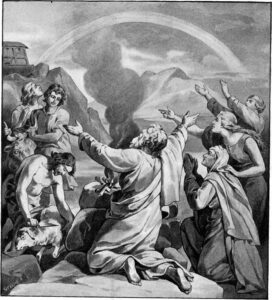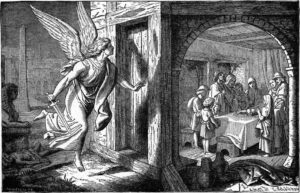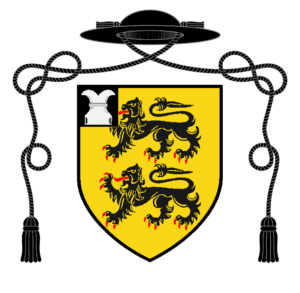I Have Given Blood to You
by Fr. William Rock, FSSP
On the first day of July is celebrated the Feast of the Precious Blood, which provides the theme for the month. It might seem, at first glance, that this Feast is paired with Corpus Christi. Corpus Christi celebrates the presence of Our Lord’s Body (Corpus Christi) hidden under the appearance of Bread. Does the Feast of the Precious Blood, then, celebrate the presence of Our Lord’s Blood under the appearance of Wine?
An examination of the texts of Corpus Christi, however, reveals that this feast, despite its name, celebrates the Eucharistic presences of both of Our Lord’s Body and His Blood. For example, the Collect, the opening prayer, of Corpus Christi reads: “O God, under a marvelous sacrament you have left us the memorial of thy Passion; grant us, we beseech thee, so to venerate the sacred mysteries of thy Body and Blood, that we may ever perceive within us the fruit of thy Redemption.”

Similarly, by examining the texts for the Feast of the Precious Blood, it becomes clear that the Feast is about celebrating, not Our Lord’s Blood under the appearance of Wine in the Holy Eucharist, but rather the Blood in Our Lord’s veins, the Blood shed in Sacrifice, the Blood hypostatically united to the Second Person of the Blessed Trinity, God the Son. For even when Our Lord’s Blood was separated from His Body on the Cross, His Blood, at least a great deal of It, was still united to Our Lord’s Divinity and worthy of divine worship. The Feast of the Precious Blood can be paired, then, with the Feast of the Sacred Heart and its devotion rather than with the Feast of Corpus Christi.
But in order to understand the importance of Our Lord’s Blood and what it should mean to the faithful, one must understand the role of blood in the Old Testament.
The first mention of blood in Holy Writ is found in the Book of Genesis. After Cain slew his brother Abel, God said to Cain that “the voice of thy brother’s blood crieth to me from the earth” (Gen 4:10). Specifically, Abel’s blood was crying out for vengeance against his brother, his murderer. As a result, the earth, which received Abel’s blood, would not yield her fruit to support Cain, who was to be a fugitive upon the face of the earth.
After the Flood, when God first gave man permission to eat meat, He said:
Let the fear and dread of you be upon all the beasts of the earth, and upon all the fowls of the air, and all that move upon the earth: all the fishes of the sea are delivered into your hand. And every thing that moveth, and liveth shall be meat for you: even as the green herbs have I delivered them all to you: Saving that flesh with blood you shall not eat. For I will require the blood of your lives at the hand of every beast, and at the hand of man, at the hand of every man, and of his brother, will I require the life of man (Gen 9:2).
This prohibition against consuming blood was enacted to express that blood was, in a unique way, connected with the life of the creature, which belongs to God. This idea is expressly presented in the Book of Leviticus: “the life of the flesh is in the blood” (Lev 17:11).

The importance given to blood is also manifested in the establishment of covenants, those sacred contracts between God and His Chosen People. After the Hebrews departed from Egypt, Moses confirmed a covenant between God and the Chosen People with a ceremony involving blood – “And [Moses] took the blood and sprinkled it upon the people, and he said: This is the blood of the covenant, which the Lord hath made with you concerning all these words” (Exo 24:8). St. Paul, in his Letter to the Hebrews, relates this event as follows: “when every commandment of the law had been read by Moses to all the people, he took the blood of calves and goats, with water, and scarlet wool and hyssop, and sprinkled both the book itself and all the people” (Heb 9:19).
Blood also served as a means of protection. As the final plague which God brought upon Egypt, an angel of death was sent to slay all of the firstborn, both of man and of beast, in the land. To protect themselves, the Hebrews were instructed to take
a lamb without blemish, a male, of one year…And you shall keep it until the fourteenth day of this month; and the whole multitude of the children of Israel shall sacrifice it in the evening. And they shall take of the blood thereof, and put it upon both the side posts, and on the upper door posts of the houses, wherein they shall eat it…And I will pass through the land of Egypt that night, and will kill every firstborn in the land of Egypt, both man and beast: and against all the gods of Egypt I will execute judgments; I am the Lord. And the blood shall be unto you for a sign in the houses where you shall be; and I shall see the blood, and shall pass over you; and the plague shall not be upon you to destroy you, when I shall strike the land of Egypt (Exo 12:5-7, 12-13).
And so it was, that the Angel of Death did indeed pass over the houses of the Hebrews thus marked with the blood of those first paschal lambs, sparing the firstborn therein.

The shedding of blood in sacrifice was given by God to the Hebrews for the expiation of sins. It is recorded in the Book of Leviticus that God spoke to the Hebrews saying: “I have given [blood] to you, that you may make atonement with it upon the altar [of sacrifice] for your souls, and the blood may be for an expiation of the soul” (Lev 17:11). The blood spilt served as a substitute for the life of the one offering the sacrifice, who deserved to die the death because of his sins. This sentiment is repeated in the Letter to the Hebrews where it is written that “without shedding of blood there is no remission [of sin]” (Heb 9:22).
The letter to the Hebrews also indicates that blood was used by the Hebrews for ceremonial purification. St. Paul relates that “almost all things, according to the law, are cleansed with blood…the tabernacle also and all the vessels of the ministry, in like manner, [Moses] sprinkled with blood” (Heb 9:22, 21)
All of these properties of blood in the Old Testament find their fulfilment in the Blood of Our Lord.
Like Abel’s blood, Our Lord’s spilt Blood cries out to heaven – “the sprinkling of blood which speaketh better than that of Abel” (Heb 12:24). But Our Lord’s Blood does not cry out for vengeance as Abel’s did, but rather it cries out for forgiveness, pardon, mercy.
Not only was Our Lord’s Blood the “the life of [His] flesh,” but it is also life-giving –
Jesus said to them: Amen, amen, I say unto you: except you eat the flesh of the Son of man and drink his blood, you shall not have life in you. He that eateth my flesh and drinketh my blood hath everlasting life: and I will raise him up in the last day. For my flesh is meat indeed: and my blood is drink indeed. He that eateth my flesh and drinketh my blood abideth in me: and I in him (Joh 6:53[54]-56[57]).
As with blood in the Old Testament, the Blood of Our Lord sealed the New and Everlasting Covenant with His Church – “This is the Chalice of My Blood of the New and Eternal Testament” (Roman Canon, see also Mat 26:28, Mar 14:24, Luk 22:20, 1 Cor 11:25).
Our Lord’s Blood is also a means of protection for the Faithful. St. John Chrysostom wrote in his commentary on the Gospel of John (Homily 84 in John, cap. 19), which the Church reads in her night office of Matins for this feast:
On that night in Egypt, when the destroying Angel saw the blood upon the lintel and on the two side-posts, he passed over the door, and came not in unto the house. Even so now much more will the destroyer of souls flee away when he seeth, not the lintel and the two side-posts sprinkled with the blood of a lamb, but the mouth of the faithful Christian, the living dwelling of the Holy Ghost, shining with the blood of the True Messiah. If the Angel let the type be, how shall not the enemy quail before the Reality?1
The Blood of Our Lord was shed in an atoning sacrifice – “This is the Chalice of My Blood…which shall be shed for you and for many unto the remission of sins” (Roman Canon, see also Mat 26:28, Mar 14:24, Luk 22:20).

In the First Chapter of his Apocalypse, St. John wrote: “Jesus Christ, who is the faithful witness, the first begotten of the dead and the prince of the kings of the earth, who hath loved us and washed us from our sins in his own blood” (Apo 1:5). Later on in the same book, St. John describes those who have “washed their robes and have made them white in the blood of the Lamb” (Apo 7:14). Our Lord’s Blood, then, is a means of purification from sin for the faithful.
And how is the Blood of Our Lord sprinkled on the faithful for the sake of their purification, their forgiveness of sin, their protection, their reception of supernatural life, and their incorporation into the New Covenant? How do the faithful associate themselves with this Blood so that It may speak on their behalf? How do the faithful participate in the Sacrifice of the New Law? All of these are accomplished by fruitfully participating, with faith, in the celebration of the Sacraments, particularly Holy Mass and the reception of Holy Communion. In this vein, as the Church presents in her Matins readings for this Feast, St. Augustine sermonized the following (120th Tract on John):
One of the soldiers with a spear pierced His Side, and forthwith came thereout Blood and Water. The Evangelist speaketh carefully. He saith not that he smote the Side, nor yet that he wounded It, nor yet anything else, but pierced It, to fling wide the entrance unto life, whence flow the Sacraments of the Church, those Sacraments without which there is no entrance unto the life which is life indeed… I have said that the Water and Blood shewed forth symbolically Baptism and the Sacraments.2
Blood crying out on behalf of the faithful, Blood as a source of divine life, Blood sealing a divine covenant, Blood as protection, Blood for the forgiveness of sins in sacrifice, and Blood as a means of purification. These are the considerations which the Church invites her children to ponder in their hearts on the Feast of the Precious Blood and, by extension, during this month of July. May you join her by so doing.
Fr. William Rock, FSSP was ordained in the fall of 2019 and is currently assigned to Regina Caeli Parish in Houston, TX.
- Translation taken from The Divinum Officium Project.
- See note 1.
July 1, 2023









